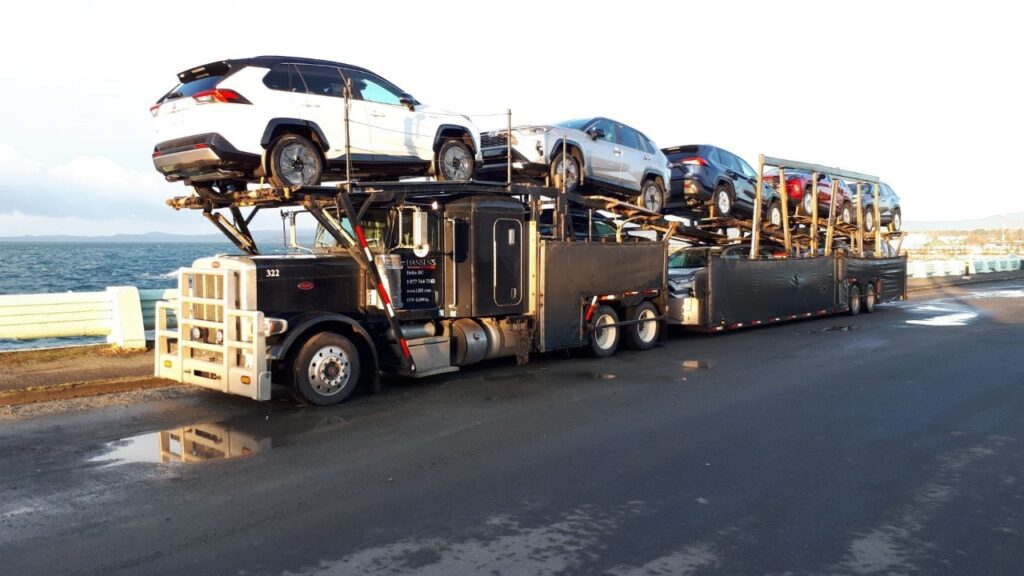Relocating to Canada from the United States often necessitates transporting your cherished automobile across the border. However, this process can be intricate, requiring careful navigation through various regulations and procedures. This article aims to provide a comprehensive overview of the steps involved in transferring a car from the USA to Canada, ensuring a smooth and hassle-free experience.
Understanding the Eligibility Criteria
Before embarking on the vehicle transfer process, it’s crucial to ensure that your car meets the eligibility criteria set forth by the Canadian government. The following factors play a significant role in determining eligibility:
| Factor | Description |
| Vehicle Age | Vehicles older than 15 years are generally prohibited from importation. |
| Safety Standards | The vehicle must comply with Canadian safety standards. |
| Emissions Standards | The vehicle must meet Canadian emissions regulations. |
| Residency Status | Different rules apply to visitors, temporary residents, and permanent residents. |
Gathering the Necessary Documents
To facilitate a smooth transfer process, you’ll need to gather several essential documents. These may include:
- Proof of ownership (e.g., vehicle title or registration)
- Proof of residency status (e.g., visa, work permit, or permanent resident card)
- Vehicle inspection report (if required)
- Emissions test report
- Proof of insurance (valid in Canada)
It’s advisable to have these documents readily available and organized to avoid delays or complications during the importation process.
Choosing the Right Import Option
There are several options available when it comes to importing your vehicle into Canada. Each option has its own set of advantages and considerations:
- Temporary Import: This option is suitable for visitors or temporary residents who plan to stay in Canada for a limited period. It allows you to import your vehicle without paying duties or taxes, provided you export it within the specified timeframe.
- Permanent Import: If you’re a permanent resident or intend to relocate to Canada permanently, you’ll need to import your vehicle permanently. This process involves paying applicable duties and taxes, as well as ensuring compliance with all necessary regulations.
- Commercial Import: If you’re a business entity importing a vehicle for commercial purposes, specific rules and regulations will apply.
Carefully evaluate your circumstances and choose the import option that best suits your needs Transferring Your Vehicle From The USA To Canada.
Understanding Duties and Taxes
When importing a vehicle permanently into Canada, you’ll be required to pay applicable duties and taxes. The exact amount will depend on factors such as the vehicle’s value, age, and country of origin. It’s essential to familiarize yourself with the current duty rates and tax regulations to budget accordingly.
Preparing for Vehicle Inspections
Depending on the circumstances, your vehicle may need to undergo certain inspections before being cleared for importation. These inspections can include:
- Safety Inspection: Conducted to ensure the vehicle meets Canadian safety standards.
- Emissions Inspection: Verifies that the vehicle complies with Canadian emissions regulations.
- Conformity Inspection: Determines if the vehicle conforms to the standards applicable to its model year and class.
It’s crucial to be prepared for these inspections and address any potential issues or modifications required to ensure your vehicle meets the necessary standards.
Choosing the Right Transport Method
Once you’ve completed the necessary paperwork and inspections, it’s time to choose the appropriate transport method for your vehicle. Several options are available, each with its own advantages and considerations:
- Self-Drive: If you’re relocating permanently or temporarily, you may be able to drive your vehicle across the border yourself. This option allows you to transport personal belongings and can be cost-effective. Shipping Auto
- Professional Auto Transport: Hiring a professional auto transport company can be a convenient and hassle-free option, especially if you’re unable to drive the vehicle yourself or if you’re shipping it from a long distance.
- Freight Shipping: For those importing a vehicle from overseas, freight shipping may be the most suitable choice. This method involves transporting your vehicle via ship or air cargo.
Consider factors such as cost, convenience, and timeline when choosing the transport method that best suits your needs.
Finalizing the Import Process
Once your vehicle has been transported to Canada, there are a few final steps to complete the import process:
- Obtain Canadian Registration and License Plates: You’ll need to register your vehicle with the appropriate provincial or territorial authority and obtain Canadian license plates.
- Secure Canadian Insurance: It’s mandatory to have valid insurance coverage for your vehicle in Canada. Explore insurance options and obtain a policy that meets the legal requirements.
- Comply with Provincial Regulations: Certain provinces or territories may have additional requirements or regulations regarding vehicle importation. Ensure you familiarize yourself with and comply with these regulations.
By following these steps and adhering to the applicable regulations, you can successfully transfer your vehicle from the USA to Canada, ensuring a smooth transition and legal operation of your vehicle in your new home.
Parting Words
Transferring a vehicle from the USA to Canada can be a complex process, but with proper planning and attention to detail, it can be accomplished smoothly. By understanding the eligibility criteria, gathering the necessary documents, choosing the right import option, preparing for inspections, and selecting the appropriate transport method, you can navigate the process efficiently.
Remember to factor in duties, taxes, and any additional provincial or territorial requirements to ensure compliance with all regulations. With careful preparation and adherence to the outlined steps, you can successfully transfer your cherished vehicle and enjoy the freedom of the open road in your new Canadian home.

